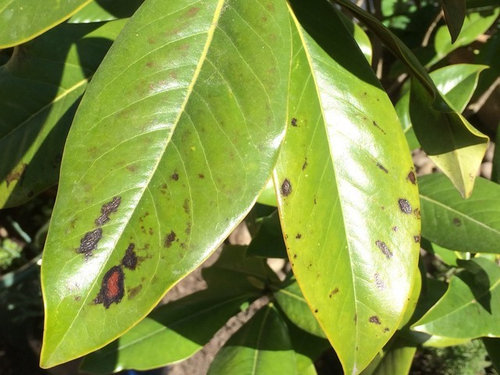Magnolia trees are prized for their beautiful flowers and lush green foliage However, homeowners are often distressed to find unsightly black spots marring the leaves of their magnolia trees What causes these black leaf spots on magnolias, and what can be done to treat them?
What Causes Black Spots on Magnolia Leaves?
There are a few common culprits behind black spots on magnolia leaves
Fungal Leaf Spot Diseases
The main cause of black leaf spots on magnolias is fungal diseases. The fungi most commonly associated with magnolia leaf spot are:
- Cladosporium spp.
- Coniothyrium spp.
- Phyllosticta magnoliae
- Septoria spp.
These fungi thrive in moist conditions. Spots usually first appear during cool, wet spring weather when the fungi can easily germinate and penetrate the leaves.
Bacterial Leaf Spot
The bacterium Pseudomonas syringae pv. syringae can also cause black leaf spots on magnolias. Bacterial leaf spot tends to develop in warm, humid climates.
Sooty Mold
Sooty mold is a black fungal growth that develops on the honeydew secreted by magnolia scale insects. The mold itself is harmless, but indicates an underlying magnolia scale infestation.
Other Causes
Insect damage, other bacterial or viral diseases, and even old age can sometimes mimic leaf spot on magnolias. Proper diagnosis is important before attempting treatment.
How to Treat Black Spots on Magnolia Leaves
If black leaf spots cover less than 20% of the leaves, treatment may not be necessary. But for more severe cases, here are some management options:
Prune Affected Leaves and Branches
Pruning off affected leaves and small branches can help reduce disease spread. Be sure to dispose of the pruned debris properly.
Apply Fungicides
Treating magnolias preventatively with copper-based fungicides like copper sulfate can help control fungal leaf spot diseases.
Increase Air Circulation
Improve air circulation around magnolias by thinning out crowded branches. This helps leaves dry out more quickly.
Water at the Base
Avoid getting the leaves wet when watering. Water magnolias at the base only.
Control Magnolia Scale
If sooty mold is present, spray magnolias with horticultural oils or insecticidal soaps to control magnolia scale insects. Ladybugs also prey on scale.
Plant Disease-Resistant Varieties
Some magnolia cultivars like ‘Ann’ and ‘Betty’ have better resistance to leaf spot diseases. Choose less susceptible varieties when possible.
How to Prevent Black Spots on Magnolia Leaves
Prevention is the best medicine when it comes to magnolia leaf spot diseases. Here are some tips:
-
Select a planting site with good air circulation and drainage.
-
Water magnolias at the base, avoiding wetting the foliage.
-
Apply mulch under magnolias to prevent splashing of spores onto leaves.
-
Prune magnolias to open up the canopy.
-
Monitor regularly for signs of pests like magnolia scale.
-
Apply fungicidal sprays on a preventative basis before disease develops.
-
Rake and dispose of fallen magnolia leaves, which may harbor inoculum.
-
Boost magnolia health with proper fertilization and irrigation. Healthy trees resist disease better.
With diligent prevention and early treatment, you can help keep your magnolia leaves looking spot-free and beautiful. But even with the best care, occasional black spots are likely in some climates. Just remove affected leaves promptly and take steps to improve conditions. A few spots here and there shouldn’t affect the overall magnolia’s health.

Lab Tests and Expert Consults
If your eyeball exam leaves you puzzled, its time to call in the big guns. Contact a plant pathology lab or a local horticulturist for a thorough workup. Theyre like the CSI of the plant world, able to spot the subtlest signs of trouble.
Collect samples of both healthy and affected leaves, following guidelines from diagnostic clinics. Document the plants environment too—light, soil, water conditions. These details can be crucial for a correct diagnosis.
Remember, the sooner you get a professional opinion, the better your chances of saving your leafy friend from the dreaded black spots.
Spotting the Culprits: Common Causes of Black Spots
Anthracnose and similar fungi are often the culprits behind black spots on Big-Leaf Magnolia leaves. These spots may start small but can expand, causing significant leaf damage. Look for circular lesions with yellow halos or dark spots with concentric rings. These are classic signs of a fungal invasion.
BLACK SPOTS on LEAVES of PLANTS (3 Causes and Solutions ✅)
FAQ
How to treat black spots on magnolia leaves?
Black spots on magnolia leaves are often caused by fungal or bacterial infections.
How do I get rid of black mold on my magnolia tree?
It is difficult to remove just by hosing down with water. Some sources suggest a liberal spraying with insecticidal soap or even diluted dish soap and leaving it in place for awhile will help to loosen the mold which can then be more easily hosed off.
How do you treat black spots on tree leaves?
Black Spot Tip: Black spot overwinters on infected foliage and rose canes. Always prune away infected stems and dispose of the debris – never compost them. Disinfect your pruners with a household disinfectant after every use. Well-intended trims with dirty pruners spread the infection.
How do you treat sooty mold on magnolia?
Once sooty mold is established, it is not easy to remove. The best method to remove the mold is to soak affected plants in a water and detergent mixture.
